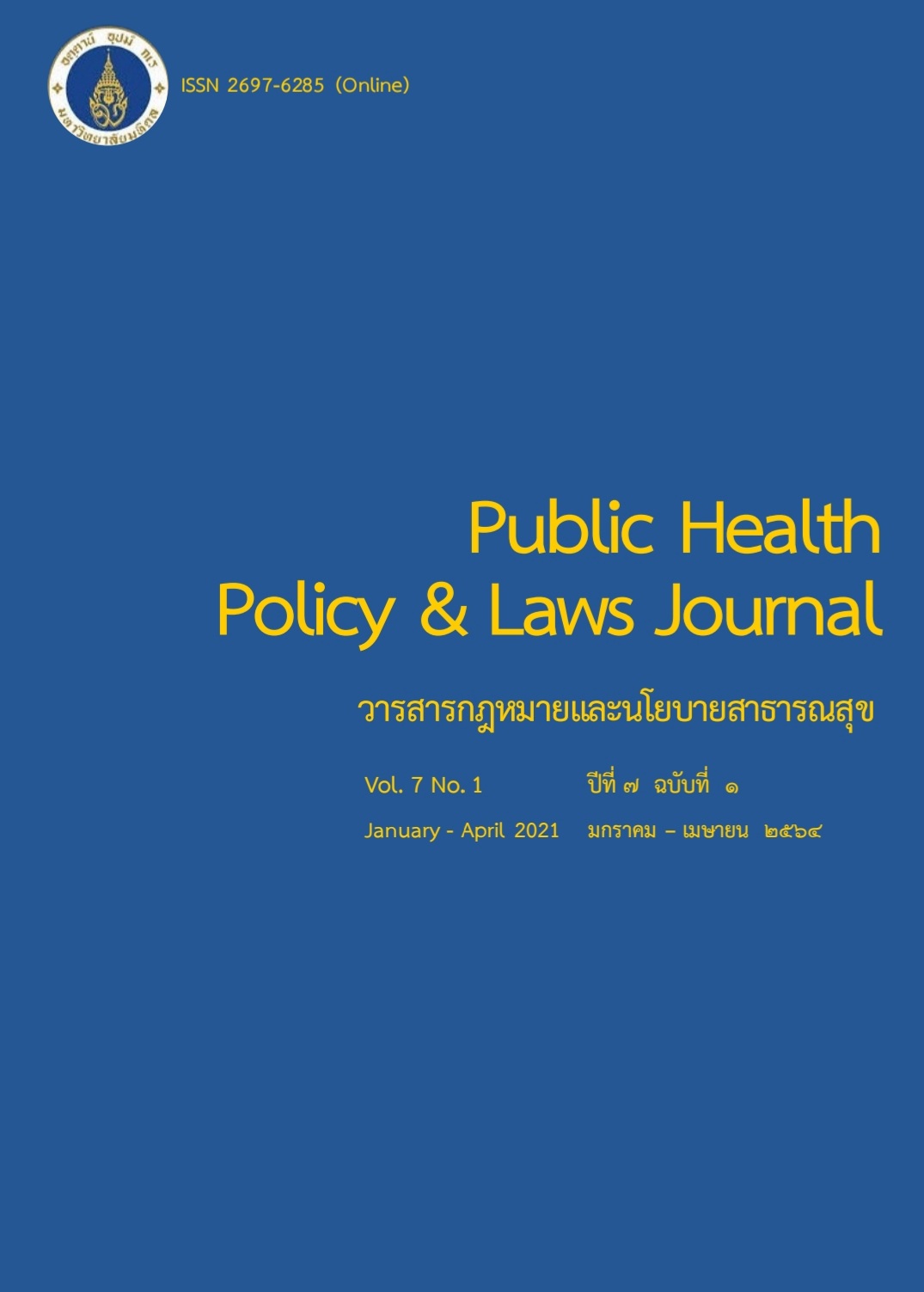Medication Errors’ Incidence in Medication Use Process: A Case Study of a Hemodialysis Unit of a Hospital
Keywords:
Incidence, Medication errors, Medication use processAbstract
This retrospective, descriptive survey research aims to study the incidence of the medication errors in the medication use process. The sample in this study were 400 electronic medical records, and hemodialysis documents (sheets data). Medication error record data were compiled for data collection. The multi-stage sampling was conducted for the electronic medical records. Statistics used were percentage, frequency, mean, and standard deviation.
The results indicated that there were 6.50% of the medication errors’ incidence in the medication use process (of the C level error), and that majority of the error (86.50) were detected before reaching patients, i.e., can be corrected within the process before administration (at the B level error).
The recommendation for hospital administration is as followed. The Hospital Information System (HIS) needs to be improved and implemented. The accuracy and precision of the HIS can reduce the medication error incidence, not only in the hemodialysis unit, but also for the entire hospital.
References
ฉัตราภรณ์ ชุ่มจิต. เยาวลักษณ์ อ่ำรำไพ. (2009). การจัดการระบบยาเพื่อความปลอดภัยด้านยาในโรงพยาบาล: บทวิเคราะห์ปัญหาและโอกาสในการพัฒนา. Thai Pharmaceutical and Health Science Journal, 4(1).
ธิดา นิงสานนท์, สุวัฒนา จุฬาวัฒนทล และปรีชา มนทกานติกุล. (บรรณาธิการ). (2554). การบริหารยาเพื่อความปลอดภัยของผู้ป่วย. กรุงเทพฯ: พันนาบรรจุภัณฑ์. พิมพ์ครั้งที่ 3, 27-32.
ปัญญฉัตร ซอสุขไพบูลย์. (2555). ระบบรายงานความคลาดเคลื่อนทางยาจากโปรแกรมคอมพิวเตอร์ที่พัฒนาขึ้นในโรงพยาบาลขนาดใหญ่แห่งหนึ่ง. วารสารเภสัชกรรมไทย, 4(1), 3-16.
เพียงเพ็ญ ชนาเทพาพร, ศมน อนุตรชัชวาล และเพียงขวัญ นครรัตนชัย. (2557). การพัฒนาระบบ การประสานรายการยาบนหอผู้ป่วยอายุรกรรมหญิง โรงพยาบาลศรีนครินทร์. ศรีนครินทร์ เวชสาร, 29(3), 276-82.
ยุพา วิภาสวัชรโยธิน, มาศรินทร์ ธรรมสิทธิ์บูรณ์. (2551). การศึกษาความคลาดเคลื่อนทางยาในโรงพยาบาลชุมพรเขตอุดมศักดิ์. เภสัชกรรมคลินิก,15, 151-61.
วรรเพ็ญ ดำนัก. (2558). โครงการพัฒนาลดความคลาดเคลื่อนทางยาจากการบริหารยาในหน่วยไตเทียม โรงพยาบาลพัทลุง [อินเตอร์เน็ต] [เข้าถึงเมื่อ 4 พฤษภาคม 2561]. เข้าถึงได้จาก www.ptlhosp.go.th/ptlkl/attachments/article/83/CQI_05.pdf.
สถาบันรับรองคุณภาพสถานพยาบาล (องค์การมหาชน). (2561). มาตรฐานโรงพยาบาลและบริการสุขภาพ ฉบับที่ 4. นนทบุรี.
Alanko K, Nyholm L. (2007). Opps! Another Medication Error: a literature review of contributing factors and method to prevent medication errors. Bachelor of Nursing. Helsinki Polytechnic Stadia, Helsinki.
Chuo J, Hicks RW. (2008). Computer-Related Medication Errors in Neonatal Intensive Care Units. Clin Perinatol, 35(1), 119-39.
Eduardo L, Steven M. (2011). Hemodialysis treatment: a fresh perspective. Clin Am Soc Nephrol, 6(10), 2522-30.
Garrick R, Alan Kliger A, Stefanchik B. (2012), Patient and facility safety in hemodialysis: Opportunities and strategies to develop a culture of safety. Clin J Am Soc Nephrol, 7(4), 680-8.
Holley JL. (2006). A descriptive report of error and adverse event in chronic hemodialysis unit. Nephrol News Issues, 29(12), 57-58, 60-61, 63.
Institute of Medicine. (2000). To err is human: Building a safer health system [Internet] [cited 2017 Feb 12]. Available from https://www.ncbi.nlm.nih.gov/books /NBK225182/pdf/Bookshelf_NBK225182.pdf.
Ledger S, Choma G. (2008). Medication reconciliation in hemodialysis patients. CANNT J, 18(4), 41-3.
Manley HJ, Drayer DK, McClaran M, Bender W, Muther RS. (2003). Drug record discrepancies in an outpatient electronic medical record: Frequency, type, and potential impact on patient care at a hemodialysis center. Pharmacotherapy, 23(2), 231-9.
Michael R Cohen. (2010). Medication errors: causes of medication errors. American Pharmacists Association. Washington, D.C, 3-14.
Miller MR, Clark JS, Lehmann CU. (2006). Computer based medication error reporting: insights and implications. Qual Saf Health Care, 15(3), 208-13.
Pennsylvania Patient Safety Advisory. (2010). Hemodialysis Administration: Strategies to Ensure Safe Patient Care, 3(7), 87-96.
Salmasi, S., Khan, TM., Hong, YH., Ming, LC., & Wong TW. (2015). Medication errors in Southeast Asian countries: A systemic review. PLOS ONE, 10(9).
Thomas - Hawkins C, Flynn L. (2015). Patient safety culture and nurse - reported adverse events in outpatient hemodialysis unit. Res Theory Nurs Pract, 29(1), 53-65.
World Health Organization. (2017). WHO launches global effort to halve medication-related error in 5 years, Geneva, Switzerland. [cited 2018 Mar 22]. Available from: http://www.who.int/mediacentre/news/releases/2017/medication-related-errors.
Downloads
Published
How to Cite
Issue
Section
License
Disclaimer and Copyright Notice
The content and information presented in articles published in the Journal of Law and Public Health Policy represent the opinions and sole responsibility of the respective authors. The editorial board does not necessarily agree with or assume any responsibility for the views expressed.
All articles, data, content, images, and other materials published in the Journal of Law and Public Health Policy are the intellectual property of the journal. Any individual or organization wishing to reproduce, distribute, or otherwise use the entirety or any part of such materials must provide proper citation.





